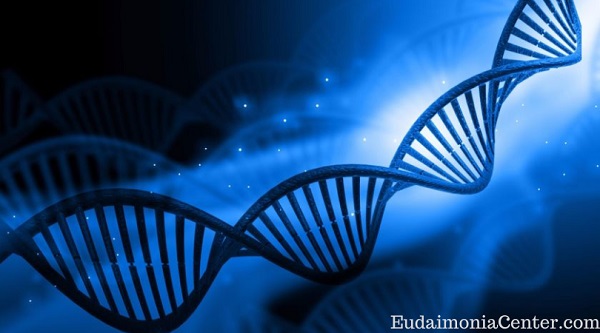Genes are Not Set in Concrete at Birth and Can be Modified

A new science has emerged over the last 20 years called Epigenetics. It is the study of changes in gene activity that is not accounted for by alterations in the genetic code, but is still passed on to the next generation. It is through epigenetic “marks” that environmental factors such as diet, stress, emotions, exposure to toxins, prenatal nutrition, and parental influences can modify and regulate genes that are passed on to future generations.
Epigenetic research has established that DNA blueprints passed down through genes are not set in concrete at birth and can be modified. Our genes are continually being modified in response to our life experiences and how we perceive them. Our cells respond to our thoughts and perceptions, and our perceptions shape our biology. Each of the 75 trillion cells in the human body has a digestive, respiratory, excretory, endocrine, nervous, reproductive, and immune system. Individual cells have intelligence and memory.
The Mind-Body Connection in our DNA
Researchers at Duke University recently concluded a long-term study on the effects of violence on children’s DNA. The study, reported in the journal Molecular Psychiatry, found that children who had experienced violence had shorter genetic structures, called telomeres, than children who did not experience violence. These children experienced physical abuse by an adult, were bullied frequently, or had witnessed domestic violence between the ages of 5 and 10. The children who were exposed to violence had wear-and-tear to their DNA similar to that seen in aging. This might explain why they face an increased risk of mental and physical disorders in adulthood. It is estimated that children who had experienced multiple types of violence had their lives reduced by 7 to 10 years.
Our mind sends out impulses of intelligence and our DNA receives it. We are continually conversing with our DNA. Our emotions influence which genes are expressed and which ones are not. Every thought and emotion we experience sends a message which impacts each cell in our bodies and is registered in the memory of each cell. This cell memory imprints automatically and unconsciously and is later referred back to continually as this has our belief system.
Our beliefs alter our biology at every moment. When we are feeling angry, isolated and tense our DNA retracts into tight coils. When we feel uplifted and open our DNA expands into graceful spirals. Our perceptions of the environment and resulting beliefs actually determine the expression of our genes and behavior. By adjusting our perceptions, we can adjust our behavior.
It is our early experiences with caregivers that shape a child’s core beliefs about self, others, and life in general. Experiences of the baby and young child are encoded in the brain. Emotional experiences of nurturance and protection are encoded in the brain’s limbic area, the emotional center. Over time, repeated encoded experiences become internal working models – core beliefs about self, self in relation to others, and the world in general. These core beliefs become the lens through which children (and later adults) view themselves and others, especially authority and attachment figures. Core beliefs serve to interpret the present and anticipate the future.
The core beliefs of children who have experienced secure in the early years will enable them to feel a safe and secure attachment to others and life feels worth living.Whereas the core beliefs of emotionally neglected children tend to have compromised attachments that not only lead to emotional and social problems, but also result in biochemical consequences in the developing brain. Infants raised without loving touch and security have abnormally high levels of stress hormones, which can impair the growth and development of their brains and bodies.
Attachment is the deep and enduring connection established between a child and caregiver in the first several years of life. It profoundly influences every aspect of the human condition — mind, body, emotions, relationships and morality.
The neurobiological consequences of emotional neglect can leave children behaviorally disordered, depressed, apathetic, slow to learn, and prone to chronic illness. Compared to securely attached children, attachment disordered children are significantly more likely to be aggressive, disruptive and antisocial. Teenage boys, for example, who have experienced attachment difficulties early in life, are three times more likely to commit violent crimes.
Disruption of attachment during the crucial first three years can lead to what has been called “affectionless psychopathy”, the inability to form meaningful emotional relationships, coupled with chronic anger, poor impulse control, and a lack of remorse. Children who experience interpersonal trauma feel rejection, pain, fear and anger.
Writing the Code of Early Experiences
The baby’s brain is an “open-loop system,” dependent on the parent’s or caregiver’s support, security and emotional connection for healthy growth and functioning.
Early attachment experiences shape the brain’s structure, chemistry and genetic expression in the following ways:
- They activate neuronal firing, creating synaptic connections between neurons (“what fires together wires together”).
- Biochemicals are triggered and released. Secure attachment between baby and parent triggers the release of Dopamine (pleasure, closeness, motivation), Endorphins (reduces pain, enhances calmness and contentment), Serotonin (stress reduction) and Oxytocin (fosters maternal behavior and bonding).
- Early experiences of secure or insecure attachment are programmed into the implicit memory systems (preverbal and unconscious) of the brain’s limbic system and become mindsets and expectations that guide subsequent behavior. For example, you may fear intimacy and dependency as an adult because of experiencing abandonment and betrayal as a child.
Change is Possible
Although,early experiences are a significant indicator of attachment patterns that an individual often carries with them into adulthood. That, however, doesn’t have to mean that a child who has experienced abandonment, lack of love, trauma or abuse in the early years must struggle with the inability to form loving and secure relationships later on.
Many studies on therapy outcome, reveal that the quality of the therapeutic relationship is the primary factor associated with positive results – more important than any theory or methods used. The experience of a healing relationship, whether it is between a therapist and client, or parent and child, is the most change-producing factor. Positive change requires a relationship in which people experience trust, safety, empathy, support, healthy boundaries, and “limbic resonance” (emotional and mental attunement).
Set yourself Free … Change is Possible. Healing is possible through with effective experiential interventions, unhealthy and damaging attachment patterns can be transformed. There are new techniques for healing using effective Energy Psychology, such as EFT. You can rapidly initiate change, any unhealthy and damaging attachment patterns can be transformed.
…. Blessings and love, Christina






